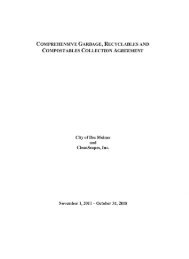CITY OF DES MOINES SHORELINE MASTER PROGRAM
CITY OF DES MOINES SHORELINE MASTER PROGRAM
CITY OF DES MOINES SHORELINE MASTER PROGRAM
Create successful ePaper yourself
Turn your PDF publications into a flip-book with our unique Google optimized e-Paper software.
Des Moines Shoreline Inventory and Characterization<br />
to experience continued economic and population growth in the coming decade and these issues<br />
will continue to require attention (City of Des Moines, 2002).<br />
Major Land and Shoreline Uses<br />
Generalized existing land use, according to King County assessor codes, is shown on Figure 7.<br />
Single-family housing is the most dominant land use within the City’s shoreline jurisdiction,<br />
representing approximately 57 percent of the City’s shoreline. Another nine percent of the<br />
shoreline is vacant but zoned for single-family residential development. The second major<br />
shoreline use in Des Moines is described as public facilities, which includes the Des Moines<br />
Marina near downtown, and the beach, boat launch, and Highline Community College Marine<br />
Science and Technology Center in the Redondo neighborhood. Public facilities comprise<br />
approximately 16 percent of the Des Moines shoreline. Commercial properties are located<br />
adjacent to the Des Moines Marina and the Redondo beach and boat launch areas. Parks make<br />
up the third largest shoreline use in the City of Des Moines, including Des Moines Beach Park<br />
and Saltwater State Park, which represent approximately nine percent of the City’s shoreline.<br />
Multi-family residential development near the south end of the Des Moines Marina and in the<br />
Redondo neighborhood comprise the remaining area (approximately five percent) along the<br />
shoreline.<br />
Water Quality<br />
Section 303(d) of the Federal Clean Water Act requires Washington State to periodically prepare<br />
a list of all surface waters in the State for which beneficial uses of the water, such as drinking,<br />
recreation, aquatic habitat, and industrial use are impaired by pollutants. The Washington<br />
Department of Ecology maintains a 303(d) list, composed of waterbodies where tested pollutants<br />
have exceeded thresholds established by the state surface water quality standards (WAC 173-<br />
201A). Streams that do not appear on the 303(d) list may fall short of that pollutant threshold,<br />
but may not be free of pollutants. In addition, not all streams are tested as part of this process.<br />
Therefore absence from the 303(d) list may not necessarily indicate that the waterbody is not<br />
impaired. The 1998 303(d) list was the last one submitted to and approved by EPA. A<br />
preliminary draft of Washington State's 2002/2003 303(d) list is currently available for public<br />
review (January 15 through March 15, 2004). Although not yet approved, the listings have been<br />
included below.<br />
Several of the streams that discharge into the Puget Sound through the Des Moines shoreline<br />
jurisdiction are included on Washington State’s 303(d) list. Some are listed for multiple<br />
pollutants. Table 2 shows the waterbodies listed in both the 1998 approved 303(d) list and the<br />
proposed 2002/2003 list, as well as the pollutants that impair their use and the medium for which<br />
they were tested.<br />
March 2005 Page 13



